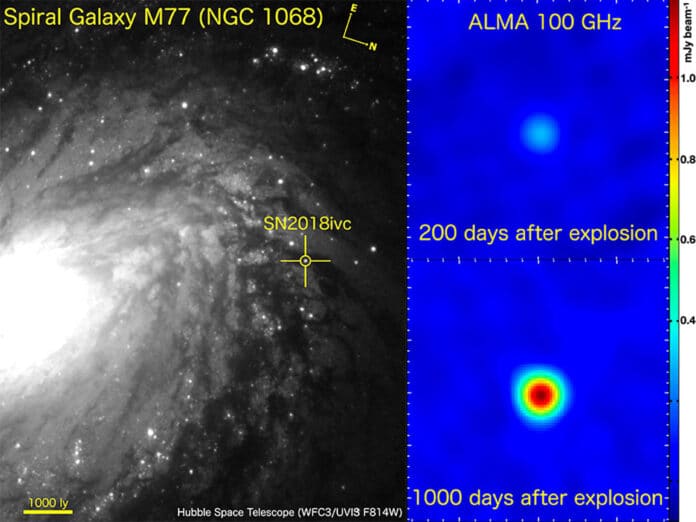A new discovery of a supernova offers an intermediate case between two types of supernovae: those of solitary stars and those in close-binary systems. Astronomers have discovered a supernova exhibiting unprecedented rebrightening at millimeter wavelengths.
Long-standing research has shown that the existence or absence of a nearby binary companion can impact large stars’ evolution. Due to gravitational interactions with the binary companion, large amounts of material will be stripped from the SN progenitor in a near binary system long before the final explosion. Under these circumstances, the progenitor will remain silent until the actual SN. On the other hand, before the SN explosion, an SN progenitor will retain most of its initial mass if it has no binary or remote companion.
What happens when the binary is not too close and not too distant?
This question has been puzzling astronomers.
An international research team, led by Keiichi Maeda (Professor at the Graduate School of Science, Kyoto University) and Tomonari Michiyama (ALMA Joint Postdoctoral Fellow at the Graduate School of Science, Osaka University), present a result of long-term monitoring of the peculiar Type IIL SN 2018ivc using ALMA.
They monitored SN 2018ivc as it dimmed for about 200 days after the initial explosion. The team decided to follow up on SN 2018ivc again roughly 1000 days after the explosion because the results indicated that it was an uncommon object. For the first time with millimeter wavelength radiation, they discovered that the object was rebrightening.
A massive hollow shell of circumstellar medium may have been produced by interaction with an intermediate-distance binary companion some 1500 years before the SN explosion, according to comparison with computer modeling. The ejecta from the explosion hadn’t yet reached the shell 200 days after the SN. After that, the ejecta impacted with the circumstellar medium sometime between 200 and 1000 days later.
Journal Reference:
- Keiichi Maeda, Tomonari Michiyama et al. Resurrection of Type IIL Supernova 2018ivc: Implications for a Binary Evolution Sequence Connecting Hydrogen-rich and Hydrogen-poor Progenitors. The Astrophysical Journal Letters. DOI 10.3847/2041-8213/acb25e
